I'm trying to use OpenCV to segment a bent rod from it's background then find the bends in it and calculate the angle between each bend.
The first part luckily is trivial with a enough contrast between the foreground and background. A bit of erosion/dilation takes care of reflections/highlights when segmenting.
The second part is where I'm not sure how to approach it.
I can easily retrieve a contour (top and bottom are very similar so either would do), but I can't seem to figure out is how to get split the contour into the straight parts and the bend rods to calculate the angles.
So far I've tried simplyfying the contours, but either I get too many or too few points and it feels difficult to pin point the right settings to keep the straight parts straight and the bent parts simplified.
Here is my input image(bend.png)
And here's what I've tried so far:
#!/usr/bin/env python
import numpy as np
import cv2
threshold = 229
# erosion/dilation kernel
kernel = np.ones((5,5),np.uint8)
# contour simplification
epsilon = 0
# slider callbacks
def onThreshold(x):
global threshold
print "threshold = ",x
threshold = x
def onEpsilon(x):
global epsilon
epsilon = x * 0.01
print "epsilon = ",epsilon
# make a window to add sliders/preview to
cv2.namedWindow('processed')
#make some sliders
cv2.createTrackbar('threshold','processed',60,255,onThreshold)
cv2.createTrackbar('epsilon','processed',1,1000,onEpsilon)
# load image
img = cv2.imread('bend.png',0)
# continuously process for quick feedback
while 1:
# exit on ESC key
k = cv2.waitKey(1) & 0xFF
if k == 27:
break
# Threshold
ret,processed = cv2.threshold(img,threshold,255,0)
# Invert
processed = (255-processed)
# Dilate
processed = cv2.dilate(processed,kernel)
processed = cv2.erode(processed,kernel)
# Canny
processed = cv2.Canny(processed,100,200)
contours, hierarchy = cv2.findContours(processed,cv2.RETR_EXTERNAL,cv2.CHAIN_APPROX_SIMPLE)
if len(contours) > 0:
approx = cv2.approxPolyDP(contours[0],epsilon,True)
# print len(approx)
cv2.drawContours(processed, [approx], -1, (255,255,255), 3)
demo = img.copy()
cv2.drawContours(demo, [approx], -1, (192,0,0), 3)
# show result
cv2.imshow('processed ',processed)
cv2.imshow('demo ',demo)
# exit
cv2.destroyAllWindows()
Here's what I've got so far, but I'm not convinced this is the best approach:
I've tried to figure this out visually and what I've aimed for is something along these lines:
Because the end goal is to calculate the angle between bent parts something like this feels simpler:
My assumption that fitting lines and compute the angles between pairs of intersecting lines could work:
I did a quick test using the HoughLines OpenCV Python tutorial, but regardless of the parameters passed I didn't get great results:
#!/usr/bin/env python
import numpy as np
import cv2
threshold = 229
minLineLength = 30
maxLineGap = 10
houghThresh = 15
# erosion/dilation kernel
kernel = np.ones((5,5),np.uint8)
# slider callbacks
def onMinLineLength(x):
global minLineLength
minLineLength = x
print "minLineLength = ",x
def onMaxLineGap(x):
global maxLineGap
maxLineGap = x
print "maxLineGap = ",x
def onHoughThresh(x):
global houghThresh
houghThresh = x
print "houghThresh = ",x
# make a window to add sliders/preview to
cv2.namedWindow('processed')
#make some sliders
cv2.createTrackbar('minLineLength','processed',1,50,onMinLineLength)
cv2.createTrackbar('maxLineGap','processed',5,30,onMaxLineGap)
cv2.createTrackbar('houghThresh','processed',15,50,onHoughThresh)
# load image
img = cv2.imread('bend.png',0)
# continuously process for quick feedback
while 1:
# exit on ESC key
k = cv2.waitKey(1) & 0xFF
if k == 27:
break
# Threshold
ret,processed = cv2.threshold(img,threshold,255,0)
# Invert
processed = (255-processed)
# Dilate
processed = cv2.dilate(processed,kernel)
processed = cv2.erode(processed,kernel)
# Canny
processed = cv2.Canny(processed,100,200)
lineBottom = np.zeros(img.shape,np.uint8)
contours, hierarchy = cv2.findContours(processed,cv2.RETR_EXTERNAL,cv2.CHAIN_APPROX_SIMPLE)
if len(contours) > 0:
cv2.drawContours(lineBottom, contours, 0, (255,255,255), 1)
# HoughLinesP
houghResult = img.copy()
lines = cv2.HoughLinesP(lineBottom,1,np.pi/180,houghThresh,minLineLength,maxLineGap)
try:
for x in range(0, len(lines)):
for x1,y1,x2,y2 in lines[x]:
cv2.line(houghResult,(x1,y1),(x2,y2),(0,255,0),2)
except Exception as e:
print e
# show result
cv2.imshow('lineBottom',lineBottom)
cv2.imshow('houghResult ',houghResult)
# exit
cv2.destroyAllWindows()
Is this a feasible approach ? If so, what's the correct way of doing line fitting in OpenCV Python ?
Otherwise, that's the best way to tackle this problem ?
Update Following Miki's advise I've tried OpenCV 3's LSD and got nicer results than with HoughLinesP but it looks like there's still some tweaking needed, although it doesn't look other than cv2.createLineSegmentDetector there aren't many options to play with:







